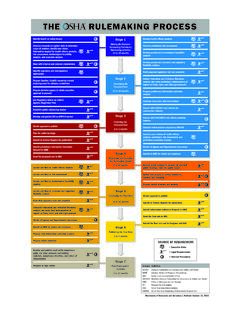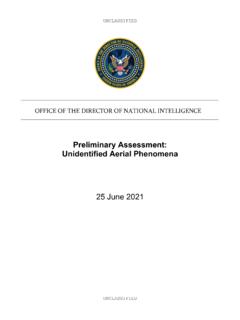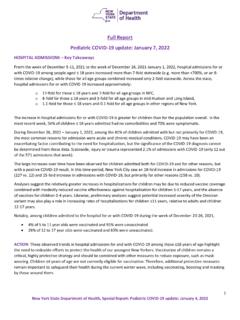Transcription of SARS-CoV-2 variants of concern and variants under ...
1 SARS-CoV-2 variants of concern and variants under investigation in England Technical briefing 35 28 January 2022 This report provides an update on previous briefings up to 14 January 2022 SARS-CoV-2 variants of concern and variants under investigation in England: Technical briefing 35 2 Contents Summary .. 3 Published information on variants .. 5 Part 1. Surveillance overview .. 6 VOC and VUI overview .. 6 Variant prevalence .. 7 Part 2. Enhanced analysis of VUI-22 JAN-01 ( ) .. 12 Epidemiology .. 12 International epidemiology .. 15 Epidemiology of SGTP .. 16 Growth rates .. 17 Secondary attack rates .. 19 Vaccine effectiveness .. 22 Part 3. Enhanced analyses of Omicron VOC-21 NOV-01 ( ) .. 23 Severity and hospitalisation .. 23 Sources and acknowledgments .. 25 Data sources .. 25 Repository of human and machine-readable genomic case definitions .. 25 Acknowledgements .. 27 SARS-CoV-2 variants of concern and variants under investigation in England: Technical briefing 35 3 Summary This report has been published to share the detailed variant surveillance analyses which contribute to the variant risk assessments and designation of new variants of concern (VOC) and variants under investigation (VUI).
2 This specialist technical briefing contains early data and analysis on emerging variants and findings have a high level of uncertainty. SARS-CoV-2 Routine variant data update covers surveillance data and sequencing coverage data on all other VOCs and VUIs. Unless stated otherwise, this technical briefing uses a data cut-off of 24 January 2022 to allow time for analyses. In summary: The Omicron variant sub-lineage was designated a variant under investigation (VUI-22 JAN-01) by the UK Health Security Agency (UKHSA) Variant Technical Group on 19 January 2022. As of 24 January 2022, 1,072 genomically confirmed cases of have been identified in England. This is a small number of cases for characterisation analysis and assessments are therefore preliminary . Sequencing data is complete up to 16 January, at which point of sequences were , were and were other lineages. does not contain the deletion at S:69-70 and is S-gene target positive (SGTP) on PCR diagnostic assays with targets in this area.
3 SGTP is now a reasonable proxy for (accounting for 80% of sequenced SGTP cases with an increasing trend). The proportion of SGTP cases is now increasing. As of the 24 January 2022, the overall proportion of SGTP cases in England is compared to on the 17 January. There is geographical variation with the highest proportion in London ( ) and the lowest in the North-East region ( ). Growth rate has an increased growth rate compared to in all regions of England where there are sufficient cases present to make an assessment. Whilst growth rates can be overestimates early in the emergence of a variant, the apparent growth advantage is currently substantial. Secondary attack rates analysis from routine contact tracing data indicated higher secondary attack rates amongst contacts of cases in households ( ; 95% CI: ) than those for contacts of other Omicron cases ( ; 95% CI: ) in the period 27 December 2021 to 11 January 2022.
4 These secondary attack rates are not adjusted for vaccination status and reflect overall growth advantage rather than transmissibility. Vaccine effectiveness A preliminary assessment did not find evidence of a difference in vaccine effectiveness against symptomatic disease for compared to However, numbers included in this study are relatively small and it will be iterated. The University of Oxford has reported preliminary unpublished pseudovirus neutralisation data. In this study, and pseudoviruses did not differ substantially in neutralisation by sera from vaccinated individuals. SARS-CoV-2 variants of concern and variants under investigation in England: Technical briefing 35 4 Omicron Omicron in care homes The VIVALDI study, investigating the epidemiology of SARS-CoV-2 infection amongst care home residents and staff in England, through collaboration with a range of Care Home Providers, finds that although there was a rapid increase in SARS-CoV-2 infections in care homes during December 2021, there has not been an associated increase in hospital admissions.
5 More follow-up time is required to confirm findings on mortality. There were very limited numbers of in this study and no inferences can be made regarding Overall, findings suggest the current wave of Omicron infections is unlikely to lead to a major surge in severe disease in care home populations with high levels of vaccine coverage and/or natural immunity. Pre-printed study results can be found at Outcomes of SARS-CoV-2 Omicron infection in residents of Long-Term Care. Updated risk assessment A new risk assessment for VUI-22 JAN-01 ( ) has been published. Feedback Survey Take our short user feedback survey. Your feedback will help us decide which features to build and what improvements could be made. SARS-CoV-2 variants of concern and variants under investigation in England: Technical briefing 35 5 Published information on variants The collection page gives content on variants , including prior technical briefings.
6 Definitions for variants of concern , variants under investigation, and signals in monitoring are detailed in technical briefing 8. The UKHSA, formerly Public Health England (PHE), has curated a repository from 5 March 2021 containing the up-to-date genomic definitions for all VOCs and VUIs. The repository is accessible on GitHub. Technical briefings are published periodically. From technical briefing 15, briefings include variant diagnoses identified by whole-genome sequencing and a genotyping polymerase chain reaction (PCR) test, including the categorisation of sequenced and genotyped variant results and a rules-based decision algorithm (RBDA) to identify variant and mutation (VAM) profiles from genotype assay mutation profiles. SARS-CoV-2 variants of concern and variants under investigation in England: Technical briefing 35 6 Part 1. Surveillance overview VOC and VUI overview Summary epidemiology for each variant and case numbers are updated online.
7 Figure 1 shows the cumulative number of cases per variant indexed by days since the first report. Figure 1. Cumulative cases in England of variants indexed by days since the fifth reported case as of 24 January 2022 (Find accessible data used in this graph in underlying data.) SARS-CoV-2 variants of concern and variants under investigation in England: Technical briefing 35 7 Variant prevalence The prevalence of different variants amongst sequenced cases is presented in Figure 2. The Other category in Figure 2 includes genomes where the quality is insufficient to determine variant status and genomes that do not meet the current definition for a VUI or VOC. The Omicron genome (lineage ) contains the spike deletion at position 69-70 which is associated with SGTF in some widely used PCR tests. Such PCR tests evaluate the presence of 3 SARS-CoV-2 genes: Spike (S), N and ORF1ab. SGTF is defined as a PCR test where the N and ORF1ab genes are detected (with Ct values <=30) but the S-gene is not.
8 SGTF patterns can be used to assess the spread of Omicron lineage The Omicron lineage , VUI-22 JAN-01, does not contain the deletion and is S-gene target positive. The number of coronavirus (COVID-19) cases with S-gene positive/SGTF by day, among those tested in TaqPath labs is shown in Figure 4. There is significant variability across the country in SGTF varying from 90% in London to 99% in the North variants of concern and variants under investigation in England: Technical briefing 35 8 Figure 2. Variant prevalence for all England available sequenced cases from 1 February 2021 as of 24 January 2022 (excluding 28 cases where the specimen date was unknown) (Find accessible data used in this graph in underlying data.) SARS-CoV-2 variants of concern and variants under investigation in England: Technical briefing 35 9 Figure 3. Number of COVID-19 cases with S-gene positive/SGTF by day, among those tested in TaqPath labs as of 24 January 2022 (95% confidence intervals indicated by grey shading.)
9 Percentages for most recent 7 days shown) (Find accessible data used in this graph in underlying data.) SARS-CoV-2 variants of concern and variants under investigation in England: Technical briefing 35 10 Figure 4. Number of COVID-19 cases with S-gene positive/SGTF by day, among those tested in TaqPath labs by region of residence as of 24 January 2022 (95% confidence intervals indicated by grey shading. Percentages for most recent 7 days shown) SARS-CoV-2 variants of concern and variants under investigation in England: Technical briefing 35 11 Figure 5. Prevalence of Pangolin lineages in UK with sequence data from 1 April 2021 to 23 January 2022 The total number of valid sequence results per week is shown by the black line. Only lineages with more than 5,000 sequences are shown. Smaller lineages are either merged with parent lineages (for example, is included in ) or are included in Other . (Find accessible data used in this graph in underlying data.
10 SARS-CoV-2 variants of concern and variants under investigation in England: Technical briefing 35 12 Part 2. Enhanced analysis of VUI-22 JAN-01 ( ) This variant is a sub-lineage of Omicron (VOC-21 NOV-01) that was designated by Pangolin on 6 December 2021. This sub-lineage does not have the spike gene deletion at 69-70 that causes SGTF. An increase in the number of sequences of the Omicron sub-lineage was noted from both the UK and Denmark in the week starting 3 January 2022. The spike profile of contains 28 mutations and a deletion at 25-27. The comparison of the Omicron sub-lineages was previously reported in Technical Briefing 31. was designated VUI-22 JAN-01 ( ) by the UKHSA Variant Technical Group on 19 January 2022. Epidemiology As of 24 January 2022, 1,072 sequences of VUI-22 JAN-01 ( ) have been identified in the UK. VUI-22 JAN-01 ( ) accounts for an increasing proportion of SGTP tests. Caution is required when interpreting comparative analyses which use S-gene target results as the only determinant of Omicron and Delta.















